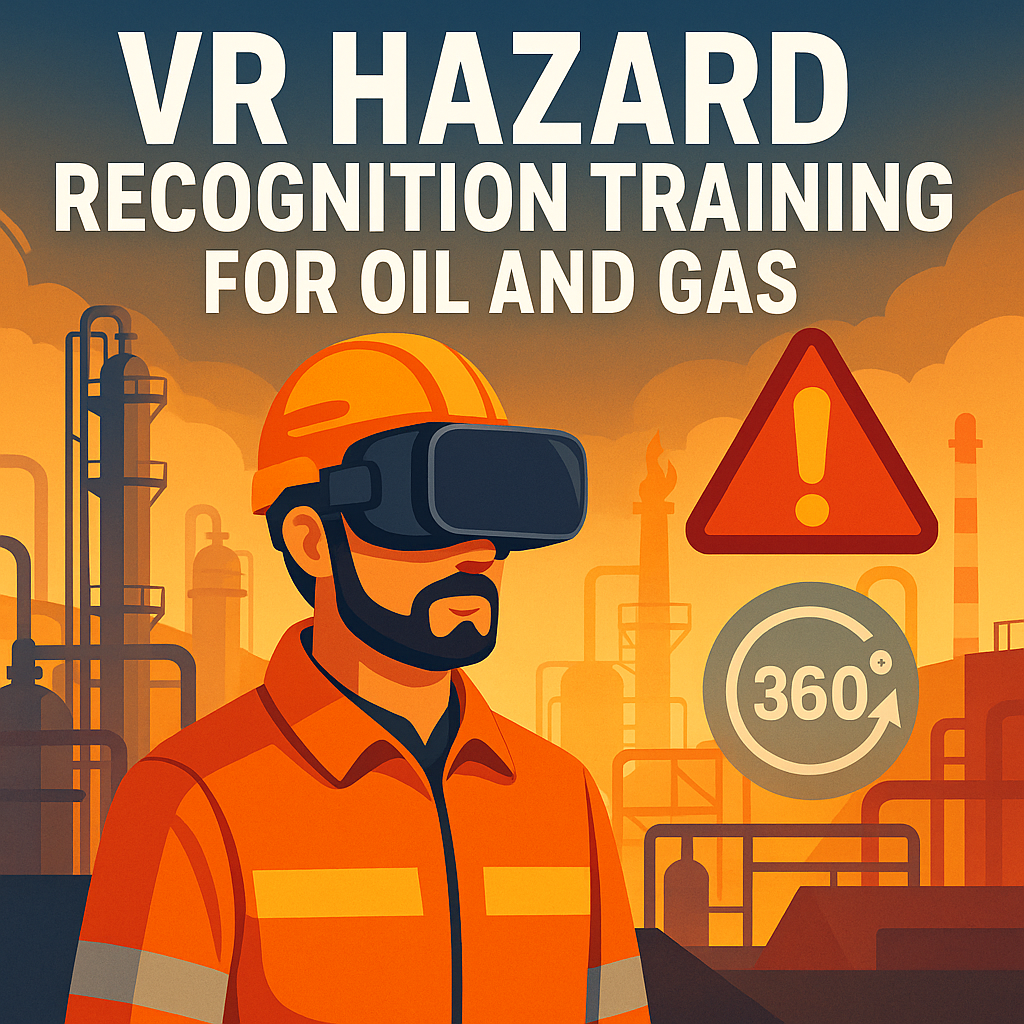⚠️ VR Hazard Recognition Training for Oil and Gas: A Smarter Way to Stay Safe 🛢️
In the high-risk environments of the oil and gas industry, one missed hazard can lead to disaster. Traditional safety training often relies on manuals, presentations, and in-person walkthroughs — but what if there were a smarter, more immersive way to prepare your workforce?
🔍 The answer: Virtual Reality (VR) hazard recognition training.
This innovative approach helps teams identify risks, rehearse emergency responses, and improve situational awareness — all in a 360° immersive space, without stepping foot in the danger zone. Let’s explore how VR hazard recognition is reshaping oil and gas safety training in 2025 and beyond.
🧠 Why Hazard Recognition Matters in Oil and Gas
Whether it’s a gas leak, equipment malfunction, or fire hazard, oil and gas sites are full of potential dangers. Effective hazard recognition training helps:
- 🛑 Prevent accidents before they happen
- 🚨 Ensure rapid, correct responses in emergencies
- 📈 Boost compliance with OSHA and international safety standards
- 👷♂️ Empower frontline workers with real-world readiness
But memorizing PowerPoints or static diagrams doesn’t cut it anymore. Workers need to see, feel, and interact with risk environments — and that’s where VR steps in.
🥽 What Is VR Hazard Recognition Training?
It’s a method of training where employees wear a VR headset or use a browser-based 360° platform to explore virtual replicas of oil and gas sites. These tours contain embedded hazards, safety signage, interactive tasks, and documentation — making safety training a dynamic, immersive experience.
With tools like CloudPano’s 360° virtual tour software, companies can create:
- Interactive walk-throughs of refineries, rigs, and plants 🏗️
- Scenario-based hazard ID drills 🔍
- Emergency simulation challenges 🔥
- Quizzes embedded into the experience ✅
🔗 Related: Boost Safety in Oil and Gas with VR-Based Hazard Recognition Virtual Tours
🚧 Common Hazards Simulated in VR
- Gas Leak Detection 💨
- Slip, Trip, and Fall Hazards ⚠️
- Chemical Spill Protocols 🧪
- PPE Compliance Zones 🧤
- Confined Space Entry Warnings 🔐
- Electrical Panel and Arc Flash Risk ⚡
- Blocked Emergency Exits 🚪
- Heavy Machinery Danger Zones 🛠️
These scenarios are built into virtual spaces so trainees can walk through, assess risks, and take action — as they would in the real world.
🔗 Related: Step Into Safety: 360 Virtual Tours for Oil and Gas Emergency Simulations
📊 Benefits of VR Hazard Recognition for Oil and Gas
✅ 1. Higher Retention & Engagement
VR learners retain up to 75% more compared to traditional classroom methods. Why? Because they’re actively involved. 🧠
✅ 2. Faster Onboarding
New workers can be trained before they ever visit the site, speeding up orientation and reducing liability.
🔗 Related: Train for Oil and Gas Emergencies with 360 Virtual Tours and Smart Documentation Tools
✅ 3. Standardized Safety Protocols
Everyone experiences the same training, the same hazards, and the same emergency protocols — reducing inconsistencies in safety messaging.
✅ 4. Real-Time Assessment
Quizzes and embedded tasks can track each user’s performance — offering instant feedback and records for compliance.
🧰 How to Get Started with VR Hazard Recognition Training
1. Capture Your Facility in 360°
Use a 360° camera (like Insta360 or Ricoh Theta) to scan your refinery, drilling site, or rig.
2. Build Your Interactive Tour
Upload footage to CloudPano or a similar VR platform. Add:
- Hotspots for hazard IDs
- Click-to-reveal safety tips
- Embedded safety documents or videos
- Interactive multiple-choice quizzes
🔗 Related: How 360 Documentation Software Powers Oil and Gas Emergency Response Training
3. Deploy to Workers
Distribute tours via:
- VR headsets (for deep immersion)
- Web browsers (for scalable desktop/mobile access)
- LMS integration (track progress and compliance)
🧪 Real-World Example
A large offshore drilling company implemented VR hazard detection simulations for new hires. Results after 3 months:
- ⏱️ 40% faster onboarding
- 🧯 60% improvement in hazard identification scores
- 📉 25% reduction in safety violations during the first 90 days
🔗 Related: Disaster Drill Simulations for Oil and Gas Made Easy with 360 Virtual Tours
🔐 Compliance & Documentation Made Easy
VR training can be documented automatically — tracking:
- Completed hazard simulations
- Quiz results and safety assessments
- Timestamped records for audits
- OSHA compliance history
🔗 Related: Digitize Oil and Gas Emergency Protocols with 360 Virtual Tour Software
🌍 Future-Proofing Safety with Smart Tech
VR hazard training doesn’t replace traditional safety culture — it enhances it. Combine it with:
- AI-based incident prediction
- IoT sensors for real-time hazard alerts
- Cloud-based documentation tools
🔗 Related: Oil and Gas Emergency Preparedness Enhanced: 360 Virtual Tours + Documentation Software
📣 Final Thoughts
Hazard recognition is a frontline defense in oil and gas safety. With Virtual Reality, you equip your team to see risks clearly, think quickly, and act safely — all before they ever face a real emergency.
If you’re serious about building a zero-incident culture, now’s the time to bring VR into your training program.














.png)



.png)





.png)

.png)





